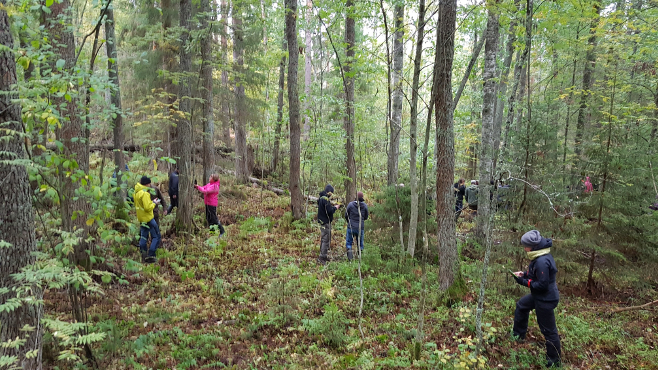The EU Biodiversity Strategy sets ambitious targets – the measures must take into account overall sustainability and different circumstances in the Member States

On 20 May 2020, the European Commission published a new Biodiversity Strategy aimed at halting the loss of biodiversity by 2030. Many of the strategy's initiatives concern the Ministry of Agriculture and Forestry, including agriculture and forestry, fisheries and water management.
The Biodiversity Strategy sets targets for nature protection and restoration and sets out measures to achieve them. The initiatives also propose a range of nature-based solutions that, in addition to safeguarding diversity, can reduce emissions from swamps, peatlands, forests, meadows and agricultural land and enhance adaptation to climate change.
Several of the proposed measures would affect forests and forestry. The Commission is also launching preparations for the EU Forest Strategy, due in 2021.
“Securing forest biodiversity is an integral part of sustainable forest policy. Finland adheres to the principle that forest policy falls within the competence of the Member States. It is essential that forest-related objectives are coordinated in a balanced way in the EU's Forest Strategy, taking into account overall sustainability”, emphasizes Minister of Agriculture and Forestry Jari Leppä.
The aim is to reconcile protection and livelihoods
The new Biodiversity Strategy sets ambitious targets for protected areas at the EU level: 30% of both the EU's land and marine areas should be protected. Currently, protected areas cover 26% of the land area and 11% of the seas, so the area would increase significantly, especially for the seas.
The strategy also sets a target for strict protection, which should cover at least 10% of both the land and maritime sectors. The strict protection target is very ambitious, as currently on average only 3% of land and less than 1% of the seas are strictly protected. Strict protection is proposed especially for carbon-rich areas such as peatlands.
The Commission's communication does not specify what the protection objectives at the EU level would mean in practice for the various Member States.
“The measures that best take into account the different circumstances of Member States can be found when implementation is done at the national level. Finland's special features are, for example, large areas of peatland and forests. The most advanced way of securing biodiversity is to take into account all dimensions of sustainable development - environmental, economic and social”, emphasizes Minister Leppä.
More than half of Europe's strictly protected forests are in Finland, and a total of 2.9 million hectares, or 13% of the total forest area, are protected.
Biodiversity is promoted also outside protected areas
It is increasingly important for nature that diversity is also promoted outside protected areas. For example, in commercial forests, nature management is an important part of sustainable forest management.
The goal of improving biodiversity is enshrined in the Finnish National Forest Strategy, and several projects are underway to support this. The most important of these is the METSO program, which the Ministry of Agriculture and Forestry will continue to implement together with the Ministry of Environment.
The HELMI habitats restoration programme, launched during the current Government’s term, protects and restores swamps, traditional biotopes and other habitats. The SOTKA project of the Ministry of Agriculture and Forestry, which improves waterfowl areas, is part of the HELMI programme. With the support of the Ministry, watercourses will also be rehabilitated to strengthen the viability of migratory fish stocks.
"Well-functioning and popular habitat restoration projects in Finland are successful examples of how the state of nature can be successfully improved also on a voluntary basis in cooperation with landowners and economic sectors," says Minister Leppä.
Support for nature management measures is included in the forthcoming forestry incentive scheme (METKA). Diversity has also been comprehensively taken into account in Metsähallitus' recently approved new ownership policy guidelines. (NB. Metsähallitus is a state-owned enterprise, responsible for the management of one third of Finland’s surface area)
In addition to overall sustainability, the Ministry of Agriculture and Forestry considers it important to commit to a science-based policy. Finland's special advantage in action on biodiversity is the advanced forest and spatial information systems compared to other countries, which are constantly being developed. A good knowledge base and monitoring help to plan cost-effective and effective measures based on the latest information.
On 20 May, the Commission also published a Farm to Fork strategy. The Farm to Fork strategy and the Biodiversity Strategy are part of the European Green Deal.
See press release of the European Commission 20 May 2020. Reinforcing Europe's resilience: halting biodiversity loss and building a healthy and sustainable food system
See also:
Press release of the Ministry of the Environment 20 May 2020: Minister Mikkonen: European Commission’s strategy an important step to halt the decline in biodiversity
Press release of the Ministry of Agriculture and Forestry 20 May 2020: EU’s new Farm to Fork Strategy a step towards developing a sustainable European food system
Read more about the European Green Deal
Inquiries at the Ministry of Agriculture and Forestry:
Teppo Säkkinen, Special Adviser to the Minister, tel. +358 50 516 2868
Marja Kokkonen, Director General, tel. +358 29 516 2444
Email addresses are in the format [email protected]